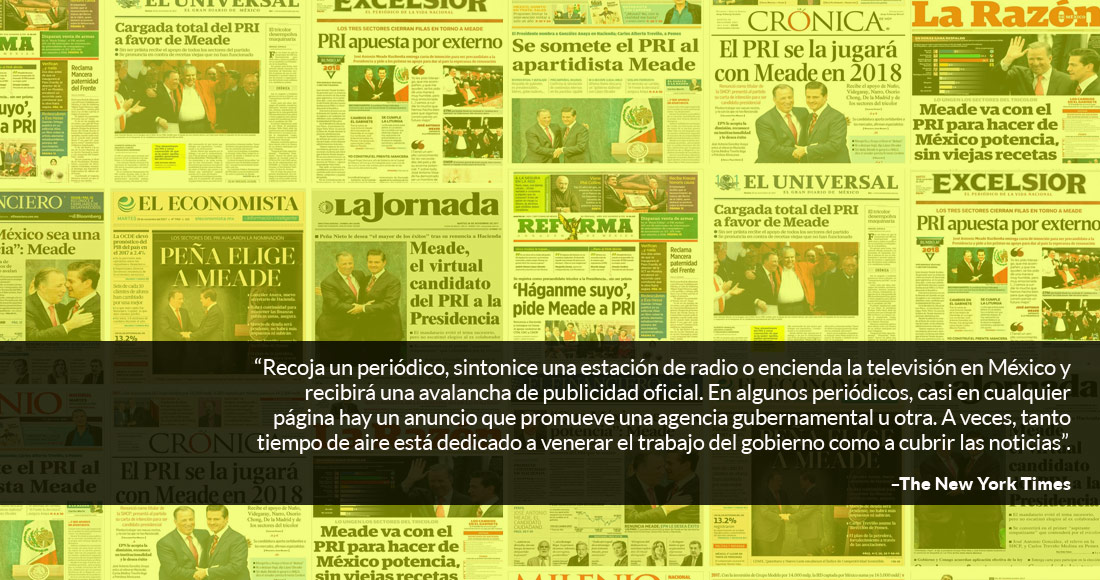New York Times report says news coverage is controlled through ad spending
Compiled by Mexico News Daily
The federal government in México has spent almost US $2 billion on media advertising in the past five years but according to a report in the New York Times, the money has bought much more than just promotional ads and television commercials.
Favorable coverage and editorial influence are also part of the deals made between the government and several media outlets, with some government press secretaries explicitly demanding positive coverage before lucrative contracts are signed, the report says.
The Enrique Peña Nieto-led Institutional Revolutionary Party (PRI) government’s lavish spending is made with a simple proviso, the Times reported: “I do not pay you to criticize me.”
Consequently, if a newspaper, radio station or television broadcaster wants to continue to receive precious advertising revenue from the government, falling into line with its demands is non-negotiable.
A very advertising budget and media organizations that depend on the revenue means that to a large extent the government has come to control the news through its spending, the Times asserted.
That control — labeled “a presidential branding juggernaut” — is “capable of suppressing investigative articles, directing front pages and intimidating newsrooms that challenge it,” the Times said.
Last year, the government spent more than twice its generous media budget, the transparency group Fundar found, while the Supreme Court ruled in November that the government must act on a presidential promise to regulate the allocation of advertising expenditure without bias.
Added to the federal money are millions of dollars that state governments also spend with their preferred media outlets to achieve the same dual end: promoting themselves and their policies through paid advertising and receiving positive editorial coverage in return.
And so a vicious cycle is created.
Federal and state officials tell editors what they should and should not publish, hard-hitting stories are often softened or abandoned altogether and a reported two-thirds of journalists censor themselves due to pressure from advertisers and editors because of the impact that critical or dissenting voices would have on a news outlet’s finances.
“If a professional reporter wants to cover the dirty elements of what is happening in the country today, neither the government nor private companies will give them a penny,” historian Enrique Krauze told the Times.
“This is one of the biggest flaws in Mexican democracy,” added Krauze, the editor of the magazine Letras Libres that also receives some government money.
But it is a flaw that has been around for a long time, starting in the early days of the seven-decade rule of the PRI, and one that is now deeply engrained in the political system.
From 2000 to 2012, when the opposition National Action Party (PAN) was in power, the practice continued.
More recently, former Chihuahua governor César Duarte — currently on the run in the United States — spent more than US $50 million on publicity and buying favorable coverage from media organizations, current state officials said.
Bribery in the state extended to journalists at a local level while new websites were created for the very purpose of attracting advertising revenue and supporting the governor’s agenda.
“The relation between the media and power is one of the gravest problems in Mexico,” Duarte’s successor, Javier Corral, told the Times.
“…It’s carrot and stick: ‘Behave well, and I’ll give you lots of money and advertising. Act badly and I’ll get rid of it,’” he added.
The federal government’s excessive spending on advertising has also been criticized because it has come at the same time as budget cuts in essential services such as health and education.
The director of the magazine Etcétera conceded that the situation is problematic but argued that if the government advertising revenue dried up, the consequences would be even worse.
“Of course, the use of public money limits freedom of expression, but without this public money there would be no media in Mexico at all,” Marco Levario said. “We are all complicit in this,” he added.
However, in a prepared statement the president’s office rejected that its spending affected free speech in any way, arguing that the purpose of its advertising is to inform and educate the public about its work and that it is backed legally by the constitution.
“There is a permanent criticism from Mexican journalists toward the government. Just by opening any newspaper, turning on the television and going to social media, you can verify this,” its statement read.
Among the newspapers the Times said have received considerable amounts of federal or state money in recent years are Excélsior, Milenio, Reforma, La Jornada and El Universal. Some media companies are part of larger conglomerates that also win government infrastructure contracts, further muddying the waters.
Last year, El Universal received about US $10 million in government advertising Fundar found, more than any other newspaper in the country.
But many of the newspapers the New York Times mentioned, including El Universal, also rejected the claims that the government unduly influences what they do and do not publish.
“The editorial line of El Universal is not for sale, it has no price and nobody can buy it,” the newspaper responded today in an editorial.
Source: The New York Times (en), El Universal (sp)



